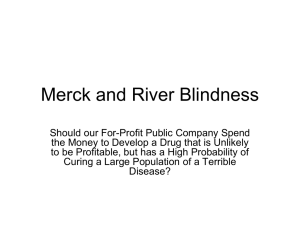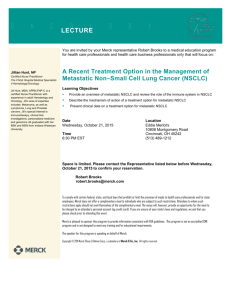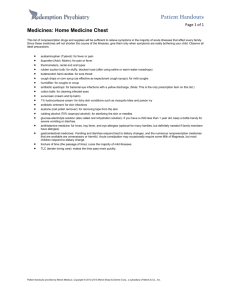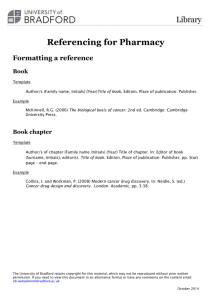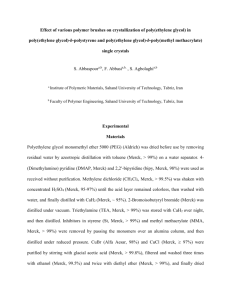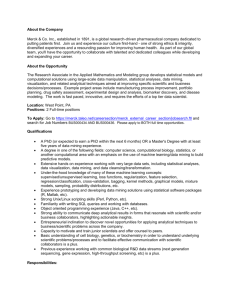ch09 - Personal.psu.edu
advertisement
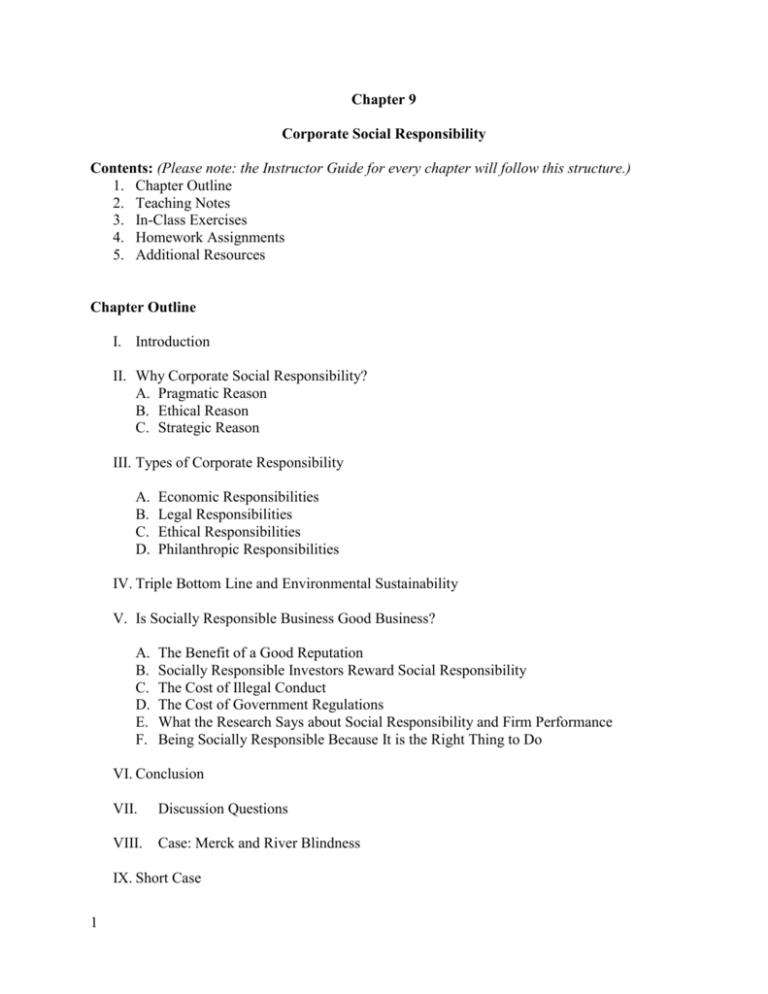
Chapter 9 Corporate Social Responsibility Contents: (Please note: the Instructor Guide for every chapter will follow this structure.) 1. Chapter Outline 2. Teaching Notes 3. In-Class Exercises 4. Homework Assignments 5. Additional Resources Chapter Outline I. Introduction II. Why Corporate Social Responsibility? A. Pragmatic Reason B. Ethical Reason C. Strategic Reason III. Types of Corporate Responsibility A. B. C. D. Economic Responsibilities Legal Responsibilities Ethical Responsibilities Philanthropic Responsibilities IV. Triple Bottom Line and Environmental Sustainability V. Is Socially Responsible Business Good Business? A. B. C. D. E. F. The Benefit of a Good Reputation Socially Responsible Investors Reward Social Responsibility The Cost of Illegal Conduct The Cost of Government Regulations What the Research Says about Social Responsibility and Firm Performance Being Socially Responsible Because It is the Right Thing to Do VI. Conclusion VII. Discussion Questions VIII. Case: Merck and River Blindness IX. Short Case 1 Teaching Notes - Discussion Questions 1. Do you think corporate social responsibility (CSR) is important? Why or why not? Depending upon the audience, many students will see the importance of social responsibility. Generally, they are conscious of some kinds of environmental concerns and have some understanding of the relationship between business and the community. But with some business school audiences, you may find resistance to the idea that corporations owe anything to society, beyond making a profit and obeying the law. So, be prepared for a debate on this one. The chapter is designed to provide students with lots of reasons to think that CSR is important. If nothing else, they should recognize the importance of corporate reputation. Probes to Stimulate Discussion: 2. Choose a company and analyze its CSR report. In doing so, think about what seem to be its reasons for being socially responsible. Is it pragmatic, ethical, strategic, or some combination? Can you identify its key stakeholders? 3. Using the same company as an example, think about the four types of corporate social responsibility. What is your assessment of how the company is doing? 4. With reference to the CSR pyramid, what are the implications of stopping at a particular pyramid level? For example, would it be all right, if a company took its sole responsibility to be the financial responsibility to its shareholders? Financial responsibility and legal responsibility? Do you agree that CSR is best represented by a pyramid? Why or why not? Can you think of a better way to graphically represent a company’s social responsibility? Obviously, the course is oriented toward the importance of ethical responsibility beyond financial and legal responsibility. Hopefully, students will see that, once they have read the chapter. Philanthropy is more discretionary, but even that tends to be expected in the US if a company is successful. Students sometimes come up with interesting alternatives to the pyramid. 5. Think about the television programs and films you have seen recently, in which business’ social responsibility (or lack thereof) was portrayed in some way. How were business and business people portrayed? Is there anything business could or should do to improve its media image? Some businesses try to stay out of the limelight. Why might that be? What do you think of that strategy? This can lead to a great discussion, because it is usually difficult for students to think of positive media portrayals of business. Those just do not make the news very often. Staying out of the limelight is certainly an option. But, if something goes terribly wrong, the company has no reputation to fall back on, no trust account to draw upon. 2 6. Do you believe that employees are more attracted and committed to socially responsible companies? Why or why not? Are you? Why or why not? There is certainly evidence for this. But, with students, ask them for their own thoughts about the companies they would hope to work for. Often, they are influenced by the company’s positive reputation for its treatment of employees, customers, etc. 7. If you were running your own company, how would you communicate your CSR strategy to employees, to external stakeholders, and why? (This is an opportunity to discuss, whether it is a good idea to “promote” a company’s CSR) In-Class Exercises Case # 1 – Merck and River Blindness: Although the decision by Merck to develop this drug for what amounted to no profits is an old one, it is still a great example of corporate social responsibility and ethical leadership. It is particularly useful, because most students have never heard of it, meaning that Merck has not “promoted” it to external audiences. On the other hand, it is clearly an important part of the company’s culture. Ask any employee about it and be prepared for a long conversation. Also, Merck did this long before corporate social responsibility was fashionable. We encourage you to search YouTube for videos on river blindness. It is harder to discuss this just in terms of the financial bottom line, once you have seen pictures of exactly what the disease is and what it does. Go to YouTube and put in the search terms “river blindness” or “Merck river blindness.” Choose a video and then decide where in the discussion it would be best to insert it. Case Questions: 1. Think about the definition of stakeholders — any parties with a stake in the organization’s actions or performance. Who are the stakeholders in this situation? How many can you list? On what basis would you rank them in importance? There are many, including employees, stockholders, people with river blindness, the communities where those people live, those with other diseases, governments, the media, perhaps competitors, etc. 2. What are the potential costs and benefits of such an investment? This is difficult, as always, because once again we have no crystal ball. The potential to discover a drug for this terrible disease certainly exists and the company’s research scientists think it is possible. The outcomes for those with the disease would be very positive and there could also be very positive media attention and reputational effects. But, there is also the potential to invest years and millions of dollars, and come up empty handed. Employee 3 morale is a potential cost or benefit. Scientists are extremely important to pharmaceutical companies and Merck’s research scientists wanted to pursue this. Allowing them to do so, might make them feel good about themselves and their work. Finally, there are opportunity costs. What drugs might “not” get discovered, because scientists were working on this one. 3. If a safe and effective drug could be developed, the prospect of Merck recouping its investment was almost zero. Could Merck justify such an investment to shareholders and the financial community? What criteria would be needed to help them make such a decision? We wrote this question, but we actually do not like it very much. Merck is clear on its website about its commitment to corporate social responsibility and to philanthropy. So, investors have the opportunity to freely decide, whether they wish to invest in a company with these values or not. Companies do not justify every investment to shareholders, so we are not convinced that they would need to justify this one. But, they certainly would not be able to justify it in terms of the financial bottom line. They would have to justify it in terms of goodwill, or some other more difficult to measure criterion. Another important discussion point here might be “which shareholders?” As the chapter discusses, some shareholders are very interested in CSR. Are we talking about those, or about day traders who have little interest in the company, other than whether they can make a short term gain? One of us heard a representative of the Business Roundtable refer to the fact that we no longer have shareholders. We have share “renters.” These are people with only short-term financial interest in the company. So, we think companies will need to look beyond these shareholders, if they wish to think about the long-term greater good of the firm and society. 4. If Merck decided not to conduct further research, how would it justify such a decision to its scientists? How might the decision to develop the drug, or not to develop the drug, affect employee loyalty? As noted earlier, a pharmaceutical company’s scientists are one of its most important resources, a point that students often miss. Of course, they know that they are working for a for-profit company. But, they are also highly trained scientists with advanced degrees, who probably have humanistic values about helping people and curing disease. So, this is an important consideration. 5. How would the media treat a decision to develop the drug? Not to develop the drug? How might either decision affect Merck’s reputation? This is tough to predict. The media may or may not even be aware of this. As noted earlier, Merck has not “promoted” itself in this way. It is possible that a media outlet would pick up the story and run with it. But, in our view, this is not a good reason to do it or not do it. A decision like this must be based upon deeply held values. 4 6. Think about the decision in terms of the CSR pyramid. Did Merck have an ethical obligation to proceed with development of the drug? Would it matter if the drug had only a small chance to cure river blindness? Does it depend on how close the company was to achieving a cure, or how sure they were that they could achieve it? Or does this decision become a question of philanthropy only? This is mostly a question of philanthropy. The other questions raised here are difficult to answer, because, when the decision must be made, we know very little about the chances of success. But, the case does raise an important ethical question that seems to affect some companies more than others. For example, if a company has information that no other person or company has and it could help people with that information, does the company have an ethical duty or obligation to act? Some students have suggested that the company share the information with someone else, who might be interested in pursuing the research. But, remember that this drug was based upon an existing Merck veterinary drug. So, we feel quite sure that Merck would not be interested in sharing its proprietary information. That leaves it with an ethical dilemma. Does it have an obligation to pursue this, because it alone has the information to do so? 7. How does Merck’s value system fit into this decision? Merck’s value system is very important here. If a company says that it values people over profits, it should act that way. Otherwise, it is just going to create a lot of cynical employees. If you do not mean it (your values, that is), do not say it! That goes for individuals too! 8. If you were the senior executive of Merck, what would you do? It is important for students to know that Merck decided to pursue the research. After about a decade and many millions of dollars, the company succeeded. They came up with a wonder drug (Mectizan) that could kill the worms on the inside and the insects biting on the outside, with seemingly few side effects. The next challenge was finding someone to buy the drug. The company had all sorts of ideas for who might help. But, there were no takers -- not the US, the UN, the World Health Organization – they all had their own priorities – and the countries and people where river blindness was rampant had no resources. So, Merck had another ethical dilemma – what to do now that they had the drug available but no one to buy it. The company made an extraordinary decision – to distribute the drug for free (to give it away) to all who needed it forever or until river blindness was eradicated! That was not the end of it though. The company had to decide how to get the drug to the distant villages where river blindness was a problem, addressing issues of poor or no transportation over terrible roads to places with no health professionals. So, the company partnered with others, to arrange for the logistics of transporting the drug to the people who needed it. Rather than provide all the details here, we direct you to read more about this story and other Merck social responsibility efforts on the Merck Company’s website. Their philanthropy program is over twenty years old, has been very successful and a model that other companies have followed. Merck remains one of the most philanthropic companies in the US. There is another notable outcome – when AIDS became a worldwide health problem, the company’s experience with the distribution of Mectizan in Africa helped. Although AIDS drugs were more complicated, the company could call on its experience to inform these new efforts. 5 One last note – at least some students will remember the Vioxx story. If you remember, Merck voluntarily recalled Vioxx a few years ago, after learning that it caused cardiovascular problems in patients who took it for 18 months or more. The recall created uproar and lots of lawsuits. Merck fought them, because of its claim that it had done nothing wrong. But after winning more cases than it lost, it finally settled the remaining cases, so that it could move on. We have found it interesting to discuss this case and contrast it with the River Blindness story. The Vioxx case is a complex one. So, if you want to do it, you will have to do some research. Maybe we will write that case to accompany the Merck case for the next edition! Case #2 – Short Case You have a long-standing consulting relationship with a large consumer products company. This company represents 50 percent of your consulting revenues and is clearly your most important client. The CEO has called, to ask you to commit a significant amount of time over the next couple of months to assist with a large merger project. The company is merging with a large conglomerate, whose primary business is the sale and distribution of tobacco products. The CEO is relying on you to assist in facilitating the smooth integration of the two companies. You promised yourself that because your father died of lung cancer, you would never work for a tobacco company. Is there a way that you can accept the consulting assignment and still keep your promise to yourself? How will you handle this dilemma, if you decide that you cannot work for the tobacco company? Probes to Stimulate Discussion: How would you feel, if this client represented a smaller portion of your company revenue – 10%? Or 30%? Exactly how would you explain your decision to your client, if you decided you could not work on this merger? Could you propose working on the part of the merger not involved with the tobacco company? If you brought in another consultant to work with you as a team – the other person working directly with the tobacco company – would that make it possible for you to continue this client relationship? Does this merger signal the end of your relationship with all parts of this organization? Can you continue to work for the non-tobacco businesses within this corporation? Homework Assignments 1. Merck River Blindness Case 6 Have students analyze the Merck River Blindness Case and answer the discussion questions. Have them write a 3 – 4 page paper, outlining their answers, or prepare a presentation for class discussion. 2. Write a Sustainability Report This is a good opportunity to have students interview a parent, friend, or find another businessperson to interview about what his/her company is doing with regards to sustainability. You could instruct them to either focus only on local companies – and interview local businesses – or focus on large and/or global companies. They could focus on companies in one country, or investigate whether there are trends in certain regions of the world. If they could give a “Sustainability” or “Green” award, what companies would they nominate and why? 3. Global 100 Analysis Students could select two companies from the Global 100 index (see Additional Resources, which follows) and compare how various companies approach the subject of social responsibility. Alone or in teams, students could investigate a company (or companies), prepare a presentation, and present their findings in class. Additional Resources: 1. Global 100 The Global 100 is a group based in Canada that rates companies globally on a sustainability index: http://www.global100.org/ 2. Newsweek’s Top 500 Sustainable Companies http://www.sustainablelifemedia.com/content/story/brands/newsweeks_500_sustainable_compan ies 3. SB20 – The World’s Top Sustainable Business Stocks http://www.sustainablebusiness.com/index.cfm/go/progressiveinvestor.sb20p1 4. Green Biz: How to Produce a Top-Notch Sustainability Report http://www.greenbiz.com/blog/2010/05/10/how-produce-topnotch-sustainability-report 5. Robust Company Sustainability Sites: A number of organizations have robust sustainability sections on their internet sites. See: 7 General Electric: http://ge.ecomagination.com/ Siemens: http://www.siemens.com/sustainability/en/index.php 8 Dell: http://content.dell.com/us/en/corp/dell-earth.aspx Unilever: http://www.unilever.com/sustainability/?WT.GNAV=Sustainability Nokia: http://www.nokia.com/environment Wal-Mart: http://walmartstores.com/Sustainability/ SC Johnson: http://www.scjohnson.com/en/commitment/focus-on.aspx
